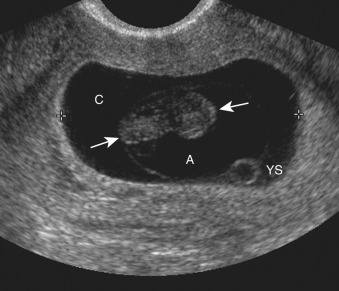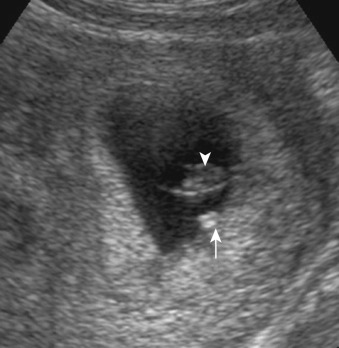Physical Address
304 North Cardinal St.
Dorchester Center, MA 02124
First-trimester US is commonly performed for both symptomatic and asymptomatic pregnant patients for a variety of reasons, including:
Confirmation, dating, and assessing viability of an intrauterine pregnancy, especially when the last menstrual date is uncertain.
Evaluating the etiology of vaginal bleeding, pelvic pain, or a pelvic mass.
Measuring embryonic nuchal translucency (NT) as part of screening for fetal chromosomal abnormalities.
Early screening of certain fetal anomalies (i.e., anencephaly) in high-risk patients.
Imaging guidance for chorionic villus sampling, embryo transfer, and localization and removal of an intrauterine device.
US in the first trimester may be performed transabdominally and/or transvaginally. Transabdominal US provides an overall view of the pelvis and is typically performed first, even without a full urinary bladder. If a normal intrauterine pregnancy is identified transabdominally, transvaginal imaging may be unnecessary. However, if an intrauterine pregnancy or the adnexa are not well visualized transabdominally, transvaginal US should be performed whenever possible. The transvaginal approach uses a higher-frequency transducer that is placed in closer proximity to the uterus and adnexa, allowing for improved resolution and possibly earlier detection of an intrauterine or ectopic pregnancy. Spectral Doppler imaging should be avoided in the first trimester.
Presence or absence, and location of a gestational sac.
Presence or absence of a yolk sac and of an embryo within a gestational sac.
Dating of a gestation based on the mean gestational sac diameter and, when possible, preferably on the embryonic crown-rump length (CRL).
Embryonic cardiac activity recorded by two-dimenstional video clip or M-mode imaging.
Number of gestations.
Other uterine and adnexal masses.
Presence or absence of pelvic fluid.
By 5 weeks of gestational age, the gestational sac is typically visible as a small, round or oval cystic-fluid collection located within the decidua of the thickened and echogenic endometrium along the upper uterine body. The gestational sac grows at a rate of 1.1 mm/day and is typically visible by a serum beta human chorionic gonadotropin (β-hCG) level of 1000 to 2000 mIU/mL. Definitive diagnosis of a pregnancy can only be made once a gestational sac contains a yolk sac and/or embryo. If a suspected gestational sac is seen without a yolk sac or embryo, then follow-up US and/or follow-up serial maternal serum β-hCG levels are performed to ensure accurate diagnosis and management of a potentially viable early pregnancy.
On US examination, an irregularly shaped gestational sac that is low-lying and surrounded by a weakly echogenic and thin rim of decidual reaction is 90% to 100% predictive of an abnormal intrauterine pregnancy. A mean gestational sac diameter that is less than 5 mm greater than the embryonic CRL, which is known as first-trimester oligohydramnios, is also associated with a poor pregnancy outcome. A mean gestational sac size of 16 to 24 mm without an embryo is suspicious for a failed pregnancy. However, a higher cutoff of 25 mm is now recommended as the mean gestation sac size by which an embryo should be seen, before diagnosing a failed pregnancy.
The yolk sac is usually seen at 5.5 weeks of gestation as a thin, circular structure, measuring between 3 and 5 mm. The embryo develops adjacent to the yolk sac and is usually seen around 6 weeks of gestation. Figure 58-1 depicts the normal early gestational US appearance of an embryo and a yolk sac within a gestation sac.

A yolk sac that is large (76 mm), fragmented, or calcified is suggestive of an abnormal intrauterine pregnancy ( Figure 58-2 ).

Become a Clinical Tree membership for Full access and enjoy Unlimited articles
If you are a member. Log in here